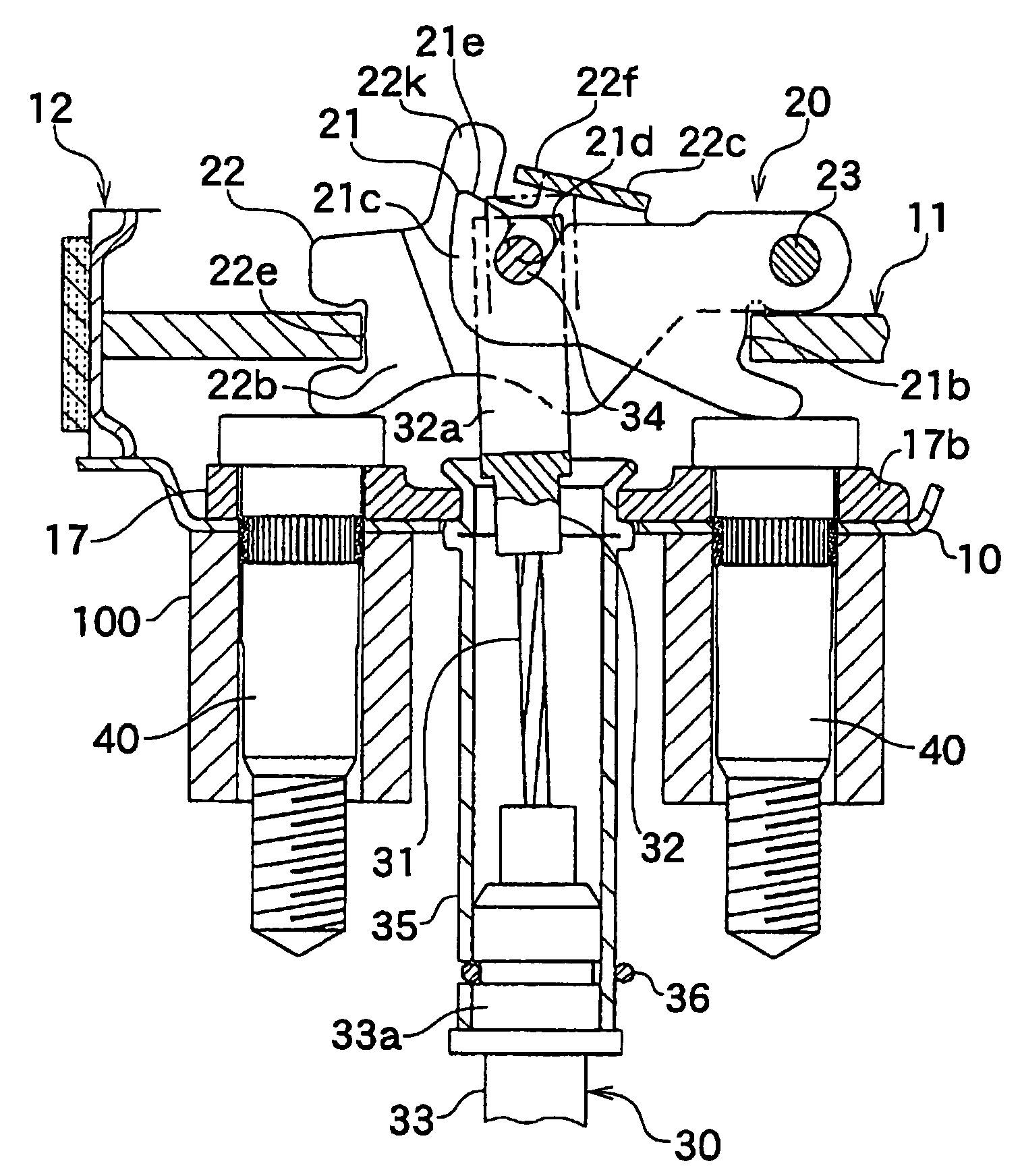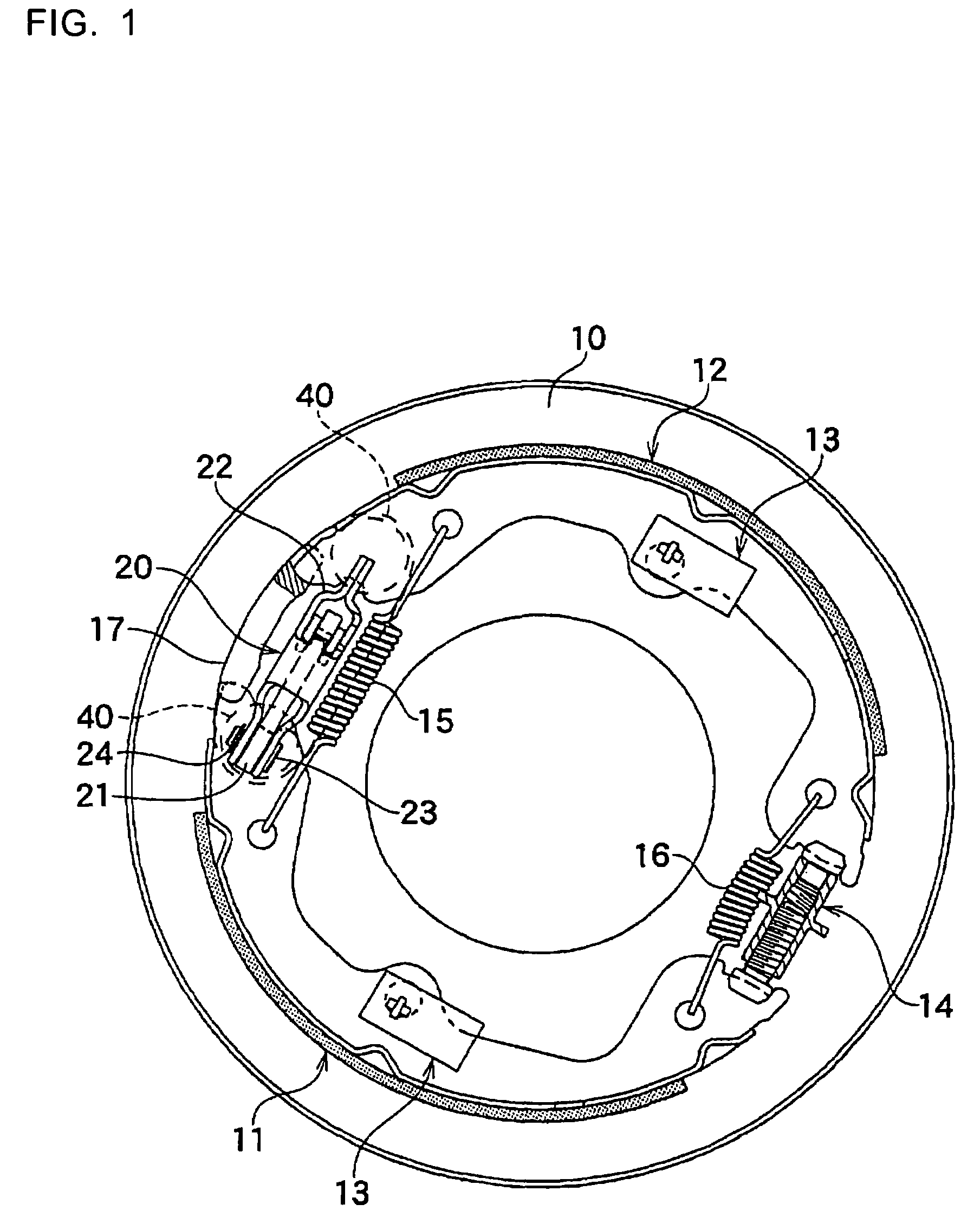Brake cable connecting apparatus
a technology of connecting apparatus and brake cable, which is applied in the direction of mechanical equipment, braking systems, transportation and packaging, etc., to achieve the effect of reducing not only material cost but processing cost, and avoiding the burden of adjusting the insertion depth of the connecting pin
- Summary
- Abstract
- Description
- Claims
- Application Information
AI Technical Summary
Benefits of technology
Problems solved by technology
Method used
Image
Examples
first embodiment
Structure / Configuration
[0037]The brake cable connecting apparatus of the first embodiment of the invention will be explained with reference to FIGS. 1-9. FIG. 1 shows a plan view of a mechanical drum brake device with a brake cable connecting apparatus. The drum brake device is such that a pair of brake shoes 11, 12 are moveably supported by shoe hold mechanisms 13, 13 on a back plate 10 fixed to a stationary part (not shown in FIG. 1) of a vehicle body while one adjacent ends are supported by an anchor 17, and the other adjacent ends are connected to a connecting member 14. Both ends of the brake shoes 11, 12 abut against and are retained by an anchor 17 and a connecting member 14 by a pair of shoe return springs 15, 16 extended between both brake shoes 11, 12. A brake actuating mechanism 20, extending between both brake shoes 11, 12, that comprises a plate-like brake lever 21, a strut 22, a pivot pin 23, and a washer 24 as shown in FIGS. 2-5 and is positioned between both brake s...
second embodiment
Structure
[0061]The brake cable connecting apparatus of the second embodiment of the invention will be explained with reference to FIGS. 10-16. The embodiment shows a stopper 22m which functions to prevent over-insertion of the clevis 32 that is added to the regulating projection 22k of the strut 22 in order to arrange the engagement holes 32b, 32b of the clevis 32 to a position where the connecting pin 34 is easily inserted.
[0062]As shown in FIG. 11 and FIG. 13, the embodiment shows an example of the regulating projection 22k, to prevent over-insertion of the connecting pin 34, formed on one of the two facing surface walls 22a outside of the brake.
[0063]In consideration of the shape when the strut 22 is formed by press work, as shown in FIG. 11-13, the strut 22 of the embodiment has the bridge 22c in a different part from that of the above-described first embodiment.
[0064]The stopper 22m is formed by bending the end portion of the regulating projection 22k, which is formed on one f...
third embodiment
[0078]The brake cable connecting apparatus of the third embodiment of the invention will be explained with reference to FIGS. 17-19. In the above-explained first and second embodiments, the resilient member, which brings return force to the brake lever 21, is the existing shoe return spring. However, the resilient member can be an independent lever return spring 50 as shown in this third embodiment.
[0079]As shown in FIG. 19, the lever return spring 50 is a torsion coil spring comprising a pair of arms 51, 52 that are formed into a V shape and where the pair of arms 51, 52 converge they are bent into a loop shape to form a coil portion 53, and the free ends of each arm 51, 52 are bent at a right angle, forming hooking portions 54, 55, each having a different length.
[0080]To explain the process of placing the lever return spring 50, as shown in FIGS. 17-18, the coil portion 53 is placed on one side of the strut 22; the pair of arms 51, 52 extending from the coil portion 53 are placed ...
PUM
 Login to View More
Login to View More Abstract
Description
Claims
Application Information
 Login to View More
Login to View More - R&D
- Intellectual Property
- Life Sciences
- Materials
- Tech Scout
- Unparalleled Data Quality
- Higher Quality Content
- 60% Fewer Hallucinations
Browse by: Latest US Patents, China's latest patents, Technical Efficacy Thesaurus, Application Domain, Technology Topic, Popular Technical Reports.
© 2025 PatSnap. All rights reserved.Legal|Privacy policy|Modern Slavery Act Transparency Statement|Sitemap|About US| Contact US: help@patsnap.com



